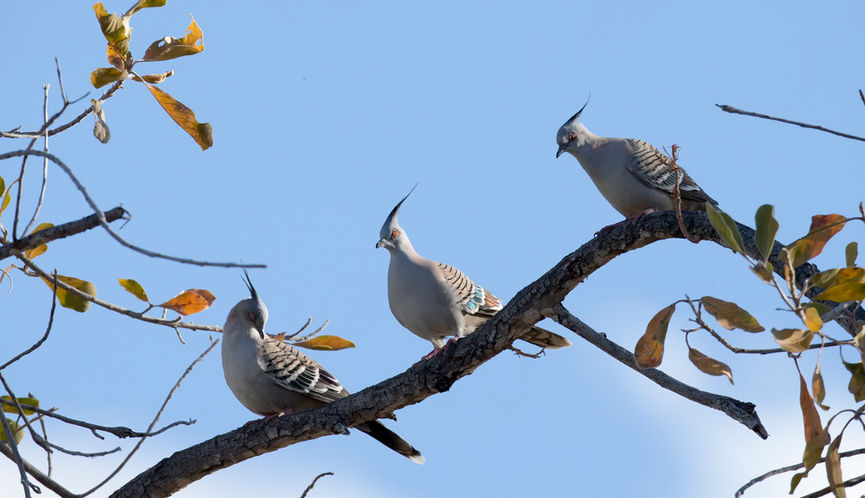Crested Pigeon
Ocyphaps lophotes
Quick facts
Other names: Topknot Pigeon (erroneous), Whistle-wing.
Size: Medium, similar to Feral Pigeon.
Range and lifestyle: Almost whole of mainland Australia.
Food: Seeds.
Breeding: Mostly July to December. Nest is untidy frail platform of sticks, built in thick foliage. Both mum and dad incubate the 2 white eggs for about 3 weeks, and feed the chicks in the nest for another 3 weeks.
Although the Crested Pigeon is often called the “Topknot Pigeon”, this name correctly belongs to a much larger pigeon that forms very large flocks and feeds on soft fruits high in the rainforest canopy. Crested Pigeons, in contrast, are seed-eaters that feed quietly on the ground in pairs or small flocks. Found over the whole of mainland Australia, the Crested Pigeon is as much at home in the desert of central Australia as in coastal woodlands, though it avoids forest. This preference for open habitats gave this species an advantage when Europeans started clearing the forests, and it became a common bird around farms after the introduction of dams and water troughs for cattle and sheep. In recent decades it has colonised urban environments, and is now a common bird in Sydney and Melbourne. Crested Pigeons were the tenth most commonly seen bird species in Brisbane backyards in the year 2000. They are social birds, usually in small flocks of five or six, but sometimes in larger flocks of a hundred or more.
One of the distinctive characteristics of these birds is the whistling noise their wings make when they take off, and research has recently shown that this noise has a purpose. Their flight consists of rapid bursts of loud wing beats, followed by long silent glides on slightly down-swept wings. The source of the whistling noise is the third flight feather from the outer edge of the wing, which is much narrower than the other flight feathers and produces a high note on the downstroke. When birds are frightened by humans or predators such as dingos, they take off with faster wing beats than normal, so fleeing birds make a different noise to those taking off normally. Scientists thought that the noise was an alarm signal to other birds in the flock, but to prove this, they taped the different sounds and played them to pigeons to see their reactions. The experiments showed that Pigeons took off when they heard the sound from birds fleeing, but not when they heard the sounds made by birds taking off normally. To prove that the unusual wing feather was responsible for signalling alarm, the scientists caught some birds, removed the feather, taped the sound made when they were released, and later played the sound to flocks in the bush to see their reaction. As expected, the flocks did not flee, proving the feather was necessary to warn the flock of danger.
The Crested Pigeon is one of several species of Australian pigeons that have iridescent patches of colour on their wings, which depending on the light, appears emerald green, purple or gold. The male has a spectacular bowing courtship display in which he lowers his breast to the ground, raises his fully-fanned, white-tipped tail until it is vertical, and opens his wings to show off the metallic colours. He then pumps his body up and down 6-8 times, giving a loud “coo” call at the bottom of each bow. There is also a flight display, in which the male flies upward steeply with the wings making a loud clapping sound, then descends in a curving glide to the branch of a tree.
Text © Richard Noske 2019 CC BY-NC-SA



















